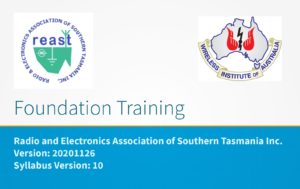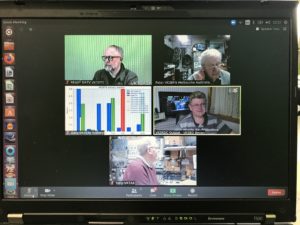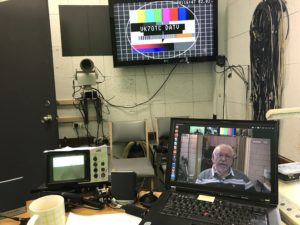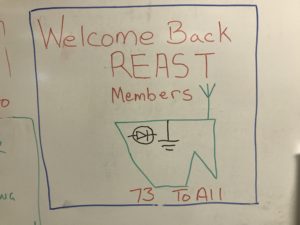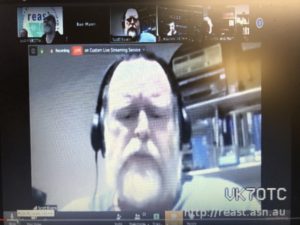October Presentation Day
It was a standing room only presentation from Peter, Kim and Denis on 3rd October 2021.
Peter VK7KPC started with FSE-58 section radio from Germany with Helmet antenna – It is crystal locked – mode is FM and runs at 24 Volt – Batteries are a 4 x 6 volt NiCd batteries. Peter shared the Italian schematics with the audience. This radio is cold war era.
https://greenradio.de/e_index.htm
We then went across the channel with a Clansman PRC-50 VHF section radio comes with handset or headset, flexible or rigid antenna and is currently on the local 6m repeater transmit frequency. There is a whisper function – low audio level and power. 14V NiCd or C-Cell battery packs.
Peter then showed a Clansman PRC-351/352 VHF manpack with carrying frame – NiCd battery pack – either 4/20W with remote antenna, similar function to the PRC-50. Comes with a hand generator and can link to a vehicle, remote operation, etc. There was also a ground spike antenna demonstrated.
https://greenradio.de/htm2/e_prc351.htm
https://greenradio.de/htm2/e_prc352.htm
We then went to a PRC-320 HF manpack. Similar batteries and functions to the PRC-351. Has a built-in ATU, comes with a leg morse key, 5/30W power settings with many aerial options. Wire antenna with tunable counterpoises, elements with metric distance/frequency tags. There was also a carry backpack and is only on USB and there are modifications available on the net.
https://greenradio.de/e_kp1j.htm
Over to Kim VK7KB – with an Australian AWA A-510 – 1940/50s AM/CW HF valve set in two boxes on your hips with interconnecting cable, crystal locked – four crystals, handset or headset, toolkit, light communicator, many dipole antennas.
https://www.qsl.net/vk2dym/radio/A510.htm
Over to an early 1960s Racal SquadCal manpack in a plastic case that actually floats! Came with handset, 5W power, HF AM/SSB/CW and was one of the early manpacks from the UK.
http://www.salbu.co.za/salbu/Squadcal_RT14_Thrower.pdf
The next manpack was the 1970s RACAL Sencal 30 with synthesised operation – decade dials to set frequency – similar functionality to the SquadCall and was a very popular radio. There were many antenna options and some built in ATU. NiCd battery pack that screws on the base and the radio came from the Royal Australian Air Force.
https://www.recelectronics.co.uk/syncal30.htm
Move to more modern radios – the QMac HF-90 – HF radios – 1990-2000s – these are built as a system much like earlier radios with sets of antennas, batteries, tuner, etc. 12-28V operation. The ground connections are interesting where the manpack actually capacitively couple to the person carrying the radio for connections to ground.
http://hfradio.com.au/codan_%20barrett_qmac%20hf_radio_information/RADIOS/Qmac_HF90.htm
Kim then moved to an American – General Dynamics GRC-106 mobile radio with RTTY terminal option, 400W power amplifier, receiver/exciter – fully synthesised HF radio. Kim pointed out they use surface connections with no pins. Known as RattRigs by the Americans. Runs on 24-28V built in late 1960-early 70s.
https://armyradio.com/GRC-106-400W-SSB-Synthesized-HF-Transmitter—Receiver.html
Denis Jackson then showed the back-up radio from boat – Morana – this is 1939 AWA WS-101 ex-military valve radio featuring a door at the base of the radio that opens to access all the eight valves – low HF frequencies and built in morse key. There was the accompanying power supply converter with vibrator DC-DC converter and battery box.
http://pa0pzd.com/army-navy/australian-army-navy/ws-101/
Denis then moved to the 1945 – 122 set – this was a transportable radio with separate vibrator power unit. It has two bands: 2 to 4 MHz and 4 to 8 MHz. The transmitter could be either crystal or VFO controlled.
https://www.radiomuseum.org/r/radiocorp_wireless_set_no_122_ws122.html
We then moved to the Domain compound for a demo of some of the accompanying antennas by Peter and Kim.
There is an accompanying video showing high resolution photos of each radio and video of Peter VK7KPC talking about some of the military radios –
A huge thank you to Peter, Kim and Denis for showing us their collection of radios.
73, REAST Committee

